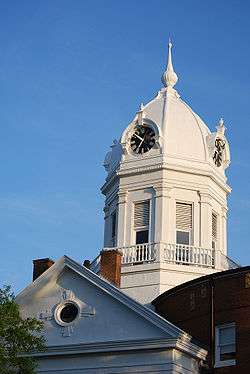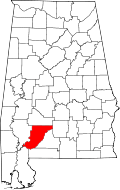Monroeville, Alabama
| Monroeville, Alabama | |
|---|---|
| City | |
|
The Old Monroe County Courthouse in Monroeville | |
| Nickname(s): The Literary Capital of Alabama | |
| Motto: "Moving the Past Forward" | |
 Location in Monroe County and the state of Alabama | |
| Coordinates: 31°31′5″N 87°19′39″W / 31.51806°N 87.32750°W | |
| Country | United States |
| State | Alabama |
| County | Monroe |
| Area | |
| • Total | 13.4 sq mi (34.7 km2) |
| • Land | 13.4 sq mi (34.6 km2) |
| • Water | 0.008 sq mi (0.02 km2) |
| Elevation | 413 ft (126 m) |
| Population (2010) | |
| • Total | 6,519 |
| • Density | 488/sq mi (188.4/km2) |
| Time zone | Central (CST) (UTC-6) |
| • Summer (DST) | CDT (UTC-5) |
| ZIP codes | 36460–36462 |
| Area code(s) | 251 Exchanges: 575,743 |
| FIPS code | 01-50192 |
| GNIS feature ID | 0152359 |
| Website |
www |
Monroeville is a city in Monroe County, Alabama, United States, the county seat of Monroe County.[1] At the 2010 census its population was 6,519.[2]
It is known as the hometown of two prominent writers of the post-World War II period, Truman Capote and Harper Lee, who were childhood friends in the 1930s. Lee's 1960 novel, To Kill a Mockingbird, earned her the Pulitzer Prize. The lasting fame of To Kill a Mockingbird became a tourist draw for the town. In 1997, the Alabama Legislature designated Monroeville and Monroe County the "Literary Capital of Alabama."
History
The town was initially known as Walker's Mill and Store, named for Major Walker, the area's first white settler. In 1832, the county seat was relocated here from Claiborne on the Alabama River. It was briefly renamed "Centerville" due to its location in the center of the county, but then formally changed to Monroeville. It did not incorporate until April 15, 1899.[3]
Geography
Monroeville is located at 31°31′5″N 87°19′39″W / 31.51806°N 87.32750°W (31.518075, -87.327543).[4]
According to the U.S. Census Bureau, the city has a total area of 13.4 square miles (34.7 km2), of which 13.4 square miles (34.6 km2) is land and 0.0077 square miles (0.02 km2), or 0.05%, is water.[2]
Demographics
| Historical population | |||
|---|---|---|---|
| Census | Pop. | %± | |
| 1880 | 122 | — | |
| 1900 | 422 | — | |
| 1910 | 616 | 46.0% | |
| 1920 | 1,017 | 65.1% | |
| 1930 | 1,355 | 33.2% | |
| 1940 | 1,724 | 27.2% | |
| 1950 | 2,772 | 60.8% | |
| 1960 | 3,632 | 31.0% | |
| 1970 | 4,846 | 33.4% | |
| 1980 | 5,674 | 17.1% | |
| 1990 | 6,993 | 23.2% | |
| 2000 | 6,862 | −1.9% | |
| 2010 | 6,519 | −5.0% | |
| Est. 2015 | 6,110 | [5] | −6.3% |
| U.S. Decennial Census[6] 2013 Estimate[7] | |||
As of the census[8] of 2000, there were 6,862 people, 2,687 households, and 1,870 families residing in the city. The population density was 525.8 people per square mile (203.0/km²). There were 3,016 housing units at an average density of 231.1 per square mile (89.2/km²). The racial makeup of the city was 53.09% White, 44.84% Black or African American, 0.38% Native American, 0.58% Asian, 0.15% from other races, and 0.96% from two or more races. 0.90% of the population were Hispanic or Latino of any race.
There were 2,687 households out of which 34.3% had children under the age of 18 living with them, 48.0% were married couples living together, 18.9% had a female householder with no husband present, and 30.4% were non-families. 28.0% of all households were made up of individuals and 11.7% had someone living alone who was 65 years of age or older. The average household size was 2.46 and the average family size was 3.04.
In the city the population was spread out with 27.7% under the age of 18, 8.9% from 18 to 24, 24.6% from 25 to 44, 22.2% from 45 to 64, and 16.6% who were 65 years of age or older. The median age was 36 years. For every 100 females there were 82.0 males. For every 100 females age 18 and over, there were 76.4 males.
The median income for a household in the city was $28,229, and the median income for a family was $36,476. Males had a median income of $35,600 versus $20,184 for females. The per capita income for the city was $17,070. About 20.4% of families and 23.0% of the population were below the poverty line, including 29.0% of those under age 18 and 19.2% of those age 65 or over.
2010 census
As of the census[9] of 2010, there were 6,519 people, 2,656 households, and 1,723 families residing in the city. The population density was 488 people per square mile (188.4/km²). There were 3,056 housing units at an average density of 228.1 per square mile (88.3/km²). The racial makeup of the city was 55.7% White, 42.1% Black or African American, 0.3% Native American, 0.3% Asian, 0.3% from other races, and 1.2% from two or more races. 0.8% of the population were Hispanic or Latino of any race.
There were 2,656 households out of which 28.4% had children under the age of 18 living with them, 39.8% were married couples living together, 21.1% had a female householder with no husband present, and 35.1% were non-families. 30.5% of all households were made up of individuals and 12.9% had someone living alone who was 65 years of age or older. The average household size was 2.37 and the average family size was 2.95.
In the city the population was spread out with 24.6% under the age of 18, 9.4% from 18 to 24, 21.8% from 25 to 44, 26.2% from 45 to 64, and 18.0% who were 65 years of age or older. The median age was 40.2 years. For every 100 females there were 87.7 males. For every 100 females age 18 and over, there were 88.5 males.
The median income for a household in the city was $31,593, and the median income for a family was $49,548. Males had a median income of $41,324 versus $31,033 for females. The per capita income for the city was $20,553. About 23.3% of families and 27.7% of the population were below the poverty line, including 37.3% of those under age 18 and 19.0% of those age 65 or over today.
Education
Monroeville is home to Alabama Southern Community College, a state-supported, fully accredited, comprehensive two-year college serving southwest Alabama with its main campuses in Monroeville and Thomasville.
Literary fame
Author Harper Lee was born and raised in Monroeville. In her book To Kill a Mockingbird, the fictional town of Maycomb is modeled on her hometown. The novel received the 1961 Pulitzer Prize for Fiction. Truman Capote, a childhood neighbor and friend of Harper Lee, grew up in Monroeville. Capote acknowledged being the inspiration for the book's character, Dill. Mark Childress, novelist, and Cynthia Tucker, syndicated columnist and winner of the 2007 Pulitzer Prize for Commentary, were also born in Monroeville.
As of 2006, an estimated 30,000 tourists visited Monroeville annually because of its association with To Kill a Mockingbird. Each May the Monroe County Heritage Museum stages an amateur play based on the book on the grounds of the courthouse. The interior of the courthouse was used as a reference for the film version of the book, and it is the venue for the later acts of the amateur production. The all-volunteer cast has been invited to perform in Washington, D.C., Kingston upon Hull, and Jerusalem.[10] In 1997 the Alabama Legislature designated Monroeville and Monroe County the "Literary Capital of Alabama."
Notable people
- Marsha Barbour, first lady of the State of Mississippi from 2004 to 2012
- Chris Booker, Major League Baseball player
- Truman Capote, author
- Mark Childress, novelist
- Marva Collins, educator
- Amasa Coleman Lee, lawyer and legislator
- Harper Lee, author of To Kill a Mockingbird and Go Set a Watchman
- Walter McMillian, exonerated former resident of Alabama's Death Row
- Allison Moorer, folk singer
- Fannie E. Motley, first African American student to graduate from Spring Hill College
- Bert Nettles, Republican politician, born in Monroeville; practices law in Birmingham
- Marie Rudisill, author and television personality
- Bill Selby, former utility player from 1996 to 2003 with the Boston Red Sox, Cincinnati Reds, and Cleveland Indians
- Cynthia Tucker, syndicated columnist
- Redd Velvet, singer, songwriter, social activist
References
- ↑ "Find a County". National Association of Counties. Retrieved 2011-06-07.
- 1 2 "Geographic Identifiers: 2010 Demographic Profile Data (G001): Monroeville city, Alabama". U.S. Census Bureau, American Factfinder. Retrieved February 1, 2013.
- ↑ http://www.encyclopediaofalabama.org/article/h-2162
- ↑ "US Gazetteer files: 2010, 2000, and 1990". United States Census Bureau. 2011-02-12. Retrieved 2011-04-23.
- ↑ "Annual Estimates of the Resident Population for Incorporated Places: April 1, 2010 to July 1, 2015". Retrieved July 2, 2016.
- ↑ "U.S. Decennial Census". Census.gov. Retrieved June 6, 2013.
- ↑ "Annual Estimates of the Resident Population: April 1, 2010 to July 1, 2013". Retrieved June 3, 2014.
- ↑ "American FactFinder". United States Census Bureau. Retrieved 2008-01-31.
- ↑ "American FactFinder". United States Census Bureau. Retrieved 2015-08-05.
- ↑ Cathy Newman "To Catch a Mockingbird", National Geographic, January 2006
External links
- City of Monroeville official website
- Monroeville/Monroe County Economic Development Authority
- Monroeville Chamber of Commerce
- Monroe County Heritage Museums
- Monroeville on the Southern Literary Trail
- Coastal Gateway Regional Economic Development Alliance
Coordinates: 31°31′05″N 87°19′39″W / 31.518075°N 87.327543°W

